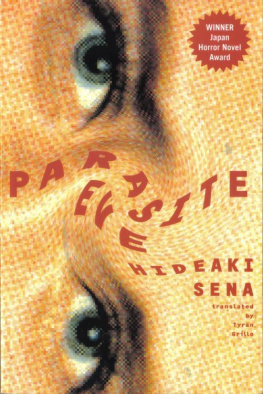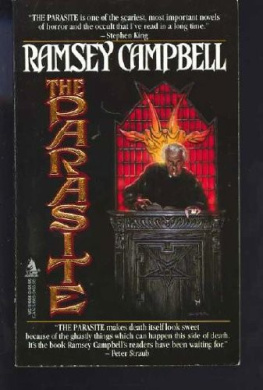ParasiteEve
ParasiteEve
by Hideaki Sena
Translated by Tyran Grillo
Copyright 2005, 2008 by HideakiSena
All rights reserved.
Published by Vertical, Inc., NewYork.
Originally published in Japaneseas Parasaito Ibu by Kadokawa Shoten, Tokyo,
1995.
Notes courtesy of Prof. ShigeoOhta translated selectively from the Kadokawa
paperback edition.
ISBN 978-1-932234-20-6
Manufactured in the United Statesof America
First Paperback Edition
Second Printing
Scanned, proof-read and EPUB/PDFby Chapu.
Digital edition 1.5 march 2011
Vertical, Inc. 1185 Avenue of theAmericas 32nd floor New York, NY 10036
www.vertical-inc.com
CONTENTS
PART ONE
PART TWO
PART THREE
Everything vanished suddenlybefore her eyes.
Kiyomi Nagashima had no ideawhat had happened. The houses she passed every day were reflected in thewindshield only a moment ago. Just ahead, the street took its familiar slopedownward and bore slightly to the right, where a traffic light had just changedto yellow, before vision failed her.
Kiyomi tried to blink, buther sight did not return. No matter how much effort she put into it, nothingappeared. They had all gone away: the white sedan driving in front of her; thetail light of the bus waiting at its stop; the cluster of high school girlshastening along the sidewalk. Kiyomi looked down in her confusion to check thesteering wheel. Then, she was truly shocked. The steering wheel was gone. Infact, she did not even know where her hands were. She could not feel the seatbelt around her waist nor her foot on the gas pedal, for neither was where itwas supposed to be. There was only darkness fanning out, continuing endlesslyin all directions.
There was a churning aroundher, and she was floating in a warm, viscous liquid. She was naked. Her clotheshad vanished without her ever noticing.
That dream again.
That dream she had once ayear, on Christmas Eve, in which she felt herself writhing in some pitch-darkworld without beginning or end. Shed always had that strange dream. This wasthe dream, and she was now entering into it again. But she did not know why shewas having it just now. Like the stars orbits, the dream always came to herwith regulated precision. She never dreamt it on any other night but Christmasand had certainly never entered into it while she was awake.
Her body was changingprofoundly. She lost all feeling in her arms and legs. Maybe theyd actuallyvanished. Head, torso, and hips gone, a body long and narrow like a worms, shefelt herself to be. Kiyomi shook and slithered ahead through the slightlysticky blackness.
What is this place? Itwas a question she had asked many times before. Her body seemed to recall thisplace, yet no matter how much she tried, Kiyomi herself could not remember.Once, in some far-off place, Kiyomi was just like this, not understandinganything, just squirming and swimming. That much was true. Had it beenyesterday, a recent year, or in the more distant past? She could not tell. Tobegin with, it was not clear that time flowed in this vast gloom.
Kiyomi felt her body changingagain. Something small divided slowly deep inside of her. At the same time, shefelt a gentle constriction in her very center, and the ends of her body flowedquietly in opposing directions.
She was becoming two.
It was a strangely tranquilfeeling. Time seemed to pass so gently, slowly.
Where am I? When is this?What am I? Such mundane concerns no longer mattered. She wanted only toremain floating like this in the dark.
She gradually split in half.There was no pain. Rather, she was insensate and that was bliss. Everythingsedate. No turmoil. Dividing like it was natural. Calm. All was calm.
Kiyomi let all her nervesrelax as she slowly surrendered herself to the flow...
Her vision was thencompletely restored just as unexpectedly as it had abandoned her. She clearlysaw now her own two hands grasping the steering wheel. Kiyomi blinked, thenlooked straight ahead.
She was heading straight intoa telephone pole.
PART ONE
Until the phone rang thatmorning, it was the beginning of an average, uneventful day for ToshiakiNagashima.
At 8:20 am Toshiaki parkedhis car at the School of Pharmaceutical Sciences. The lot was still more thanhalf empty. Briefcase in hand, he got out of the car and locked it. He lookedup indifferently at the Pharmaceutical Center. Rising six stories high, thebuilding was steeped in somber gray beneath the cloudy sky.
In the entrance lobby,Toshiaki changed into a pair of sterile sandals, then took the elevator to thefifth floor. Double doors opened to reveal a corridor extending in bothdirections. Far back to the right was the lecture hall where he taught hiscourse on Advanced Methods in Biofunctional Sciences. It appeared that most ofthe students and other staff members had yet to arrive, for not a sound couldbe heard. However, late mornings were not unusual. The other organic sciencecourses were quite different, entire staffs assembling and seminars beginningat 8 am. Toshiakis course was an exception in that they wasted no time onfinding fault with their students time management skills. Instead, he and hiscolleagues stressed that what mattered was for the students to conduct theirexperiments and present the data.
As a mere research associate,Toshiaki made an effort to arrive by 8:30, but this was not a commitmentrequired of him.
He opened the door to Lab 2,which housed his desk, turned on the light, and entered. After hanging hiscoat, he placed his briefcase next to the bookshelf. Two chemical agent orderforms had been written up and left for him on the desk by his students thenight before: specifically, requests for the restriction enzymes EcoR I andBamH I. Toshiaki attached theforms together with a paper clip and pinned them to the desk-side wall.
Looking over the notes hedmade the day before, he began to prepare for his experiment. First he left thelab and keyed open a door just down the hall which led into the CultivationRoom. The rooms interior was imbued with a ultraviolet sterilizing light,which he switched to an ordinary fluorescent light as he stepped inside. Hetook two plastic culture flasks from the incubator and placed them under amicroscope. He adjusted the focus and peered through the lenses, gazing at thecells at the other end. After ensuring he was satisfied with their condition,he returned the cells to the incubator, then removed a few implements from theautoclave and placed them into the clean bench.
Toshiaki returned to his laband removed several testing chemicals from the refrigerator. Just then, SachikoAsakura, a second- year masters student he had been mentoring, walked in.
Good mor-ning, sheenunciated pleasantly as she entered.
Toshiaki returned thegreeting like an echo.
Asakura put her coat away,revealing a figure shrouded in a white summer sweater and jeans. She had herlong hair tied behind her back. Removing her sweater, she donned a white labcoat.
At nearly 59, Asakura wasquite tall for a woman, shorter than Toshiaki by only an inch or so. When shepassed by, she acknowledged him with a smile and a small bow. Asakuras heightwas greatly accentuated in her long coat, and it was always pleasant to watchher stately figure as it fluttered about the lab during an experiment.
Toshiaki informed her hewould be in the Cultivation Room and, with that, left the lab.
Once the clean benchpreparations were complete, he removed the culture flasks and commenced hiswork. The cells he was using, known as NIH3T3,into the indicator solutions. Today, he planned on collecting mitochondrialdata from both cultures. His expectation was that the activity of the-oxidation enzymes would be higher for the cells receiving the genetransfer than for the control cells.
Next page









